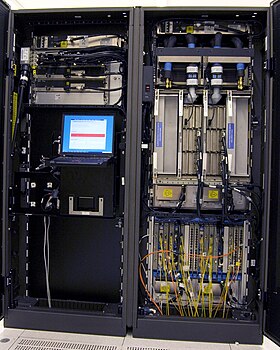Design

Modern mainframe design is characterized less by raw computational speed and more by:
- Redundant internal engineering resulting in high reliability and security
- Extensive input-output ("I/O") facilities with the ability to offload to separate engines
- Strict backward compatibility with older software
- High hardware and computational utilization rates through virtualization to support massive throughput.
- Hot-swapping of hardware, such as processors and memory.
Their high stability and reliability enable these machines to run uninterrupted for very long periods of time, with mean time between failures (MTBF) measured in decades.
Mainframes have high availability, one of the primary reasons for their longevity, since they are typically used in applications where downtime would be costly or catastrophic. The term reliability, availability and serviceability (RAS) is a defining characteristic of mainframe computers. Proper planning and implementation are required to realize these features. In addition, mainframes are more secure than other computer types: the NIST vulnerabilities database, US-CERT, rates traditional mainframes such as IBM Z (previously called z Systems, System z and zSeries), Unisys Dorado and Unisys Libra as among the most secure with vulnerabilities in the low single digits as compared with thousands for Windows, UNIX, and Linux. Software upgrades usually require setting up the operating system or portions thereof, and are non-disruptive only when using virtualizing facilities such as IBM z/OS and Parallel Sysplex, or Unisys XPCL, which support workload sharing so that one system can take over another's application while it is being refreshed.
In the late 1950s, mainframes had only a rudimentary interactive interface (the console) and used sets of punched cards, paper tape, or magnetic tape to transfer data and programs. They operated in batch mode to support back office functions such as payroll and customer billing, most of which were based on repeated tape-based sorting and merging operations followed by line printing to preprinted continuous stationery. When interactive user terminals were introduced, they were used almost exclusively for applications (e.g. airline booking) rather than program development. Typewriter and Teletype devices were common control consoles for system operators through the early 1970s, although ultimately supplanted by keyboard/display devices.
By the early 1970s, many mainframes acquired interactive user terminalsNB operating as timesharing computers, supporting hundreds of users simultaneously along with batch processing. Users gained access through keyboard/typewriter terminals and specialized text terminal CRT displays with integral keyboards, or later from personal computers equipped with terminal emulation software. By the 1980s, many mainframes supported graphic display terminals, and terminal emulation, but not graphical user interfaces. This form of end-user computing became obsolete in the 1990s due to the advent of personal computers provided with GUIs. After 2000, modern mainframes partially or entirely phased out classic "green screen" and color display terminal access for end-users in favour of Web-style user interfaces.citation needed
The infrastructure requirements were drastically reduced during the mid-1990s, when CMOS mainframe designs replaced the older bipolar technology. IBM claimed that its newer mainframes reduced data center energy costs for power and cooling, and reduced physical space requirements compared to server farms.
Comments
Post a Comment